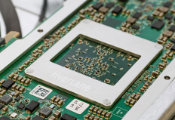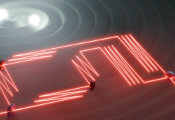Experimental Evidence of High Harmonic Generation Producing Quantum Light
November 28, 2024 -- High harmonic generation (HHG) is a highly non-linear phenomenon where a system (for example, an atom) absorbs many photons of a laser and emits photons of much higher energy, whose frequency is a harmonic (that is, a multiple) of the incoming laser’s frequency. Historically, the theoretical description of this process was addressed from a semi-classical perspective, which treated matter (the electrons of the atoms) quantum-mechanically, but the incoming light classically. According to this approach, the emitted photons should also behave classically.
Despite this evident theoretical mismatch, the description was sufficient to carry out most of the experiments, and there was no apparent need to change the framework. Only in the last few years has the scientific community begun to explore whether the emitted light could actually exhibit a quantum behavior, which the semi-classical theory might have overlooked. Several theoretical groups, including the Quantum Optics Theory group at ICFO, have already showed that, under a full quantum description, the HHG process emits light with quantum features.
However, experimental validation of such predictions remained elusive until, recently, a team led by the Laboratoire d’Optique Appliquée (CNRS), in collaboration with ICREA Professor at ICFO Jens Biegert and other multiple institutions (Institut für Quantenoptik - Leibniz Universität Hannover, Fraunhofer Institute for Applied Optics and Precision Engineering IOF, Friedrich-Schiller-University Jena), demonstrated the quantum optical properties of high-harmonic generation in semiconductors. The results, appearing in Physical Review X Quantum, align with the previous theoretical predictions about HHG.
In the reported experiment, the HHG source operates at room temperature using standard semiconductors and a commercial femtosecond infrared laser. This accessibility positions HHG as a highly promising platform for generating nonclassical states of light, which in turn can pave the way for more robust and scalable quantum devices that do not require complex cooling systems.
Two unmistakable signs of quantum light
Theoreticians had already predicted that the photons emitted through an HHG process exhibit quantum behavior, which manifests itself in two defining features: entanglement and squeezing.
Entanglement occurs when two particles become interconnected, such that measuring one instantaneously influences the outcome after measuring the other, regardless of the distance between them. These strong correlations defy classical intuition and can only occur in the quantum world of atoms, electrons, and photons.
Squeezing, on the other hand, relates to the unavoidable uncertainty when measuring certain pairs of properties in a quantum system: increasing the measurement precision for one quantity will decrease the measurement precision for the other. Squeezed states embrace this trade-off. At the expense of increasing the noise of one property of the pair, they can reduce the noise of the complementary property.
In agreement with previous theoretical predictions, the team experimentally demonstrated the presence of both entanglement and squeezing in the emitted light. But how did they achieve it?
Evidencing the quantum nature of HHG
First, the researchers directed ultrafast infrared laser pulses onto semiconductor samples —gallium arsenide, zinc oxide, and silicon—to drive high-harmonic generation. From all the generated harmonics, they selected only two of them (the third and the fifth) using optical filters. These were then sent to a detection system capable of simultaneously analysing multiple harmonics, which was critical to reveal the quantum behavior of light.
The first sign of quantumness was related to squeezing. The equipment recorded that the variance of the photon arrival times (and, therefore, the uncertainty associated to this quantity) decreased as the laser intensity increased. This reduction could only be explained by squeezing, providing solid evidence of this feature. After that, the team turned to entanglement. To demonstrate it, they measured the correlation between the arrival times of photons from the third and fifth harmonics. Researchers consistently observed strong correlations that are prohibitive for a classical source, unmistakably indicating the presence of quantum entanglement.
These findings establish high harmonic generation as an ideal platform for producing entangled and squeezed photonic systems at room temperature. “Both features are key resources for many quantum technologies, which, for instance, rely on entanglement to transmit information or on squeezing to enhance measurement precision”, explains ICREA Prof. Jens Biegert. “Neglecting the quantum optical effects was hindering the possibility of detecting nonclassical features. But, hopefully, now we will be able to exploit HHG for quantum information, communication and sensing applications in all its potential.”




































